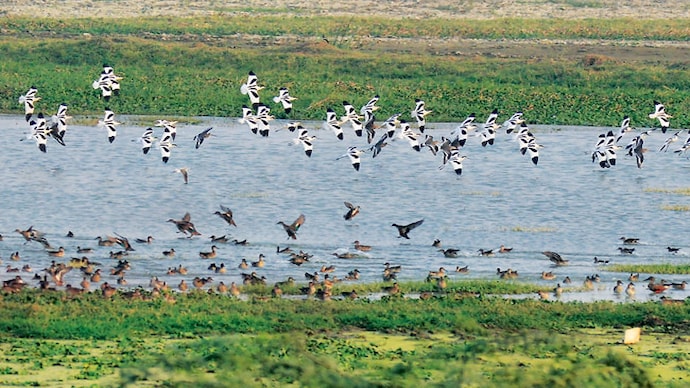16 different species of migratory birds flock to Najafgarh
These include the International Union for Conservation of Nature (IUCN) red-listed Painted Stork, Sarus Crane, Black-Necked Stork, Black-Tailed Godwit and Black-Headed Ibis.


Even as Delhi's prominent and protected bird habitats lay waiting for migratory birds, the seasonal visitors have chosen to make a sewage drain - the Najafgarh nullah and jheel - their home in the city.
Over 5,000 birds of at least 16 different species have arrived here already. These include the International Union for Conservation of Nature (IUCN) red-listed Painted Stork, Sarus Crane, Black-Necked Stork, Black-Tailed Godwit and Black-Headed Ibis.
Peace and security
In comparison, the famous Okhla Bird Sanctuary has received only around 1,000 birds spanning 10 species, most of which are suspected to have flied out due to disturbance already.
Birdwatchers in Delhi say the Najafgarh drain and jheel is emerging as a preferred destination for winter migratory birds due to its quiet surroundings and a semblance of security. More birds are expected to land here as the winter months roll out.
The Najafgarh drain runs from Haryana to Uttam Nagar, submerging into Yamuna finally. It is the stretch from the Chhawla BSF Camp to Haryana border post which birds have found most suitable. It is lined by a thick growth of keekar trees on both sides which makes the drain inaccessible for miscreants. At the Haryana border, where the drain spreads out over a huge area of farmlands, the birds have come to roost mainly.
Delhi coordinator of the Asian Waterbird Census T.K. Roy says: "Najafgarh jheel is already listed with BirdLife International as an Important Bird and Biodiversity Area (IBA). In the last two years, however, we have seen a marked increase in the population and diversity of winter migratory birds here, over and above the Okhla Bird Sanctuary, Sultanpur Nation Park, Dadri Wetlands etc. This time, however, the number of birds here is really impressive. It seems the birds have found an alternative habitat in the city."
Migratory water birds to be spotted here this time include Greater Flamingos which come from Gujarat, Maharashtra and Orissa's coastline; Bar-Headed Geese which breed in Central Asia; Pied Avocet from Western Europe and Africa; Northern Shoveler; Ruddy Shelduck; Common Coot; Red-Crowned Ibis; Gadwal; Ruff; Common Coot and Eurasian Spoonbill.
Roy says: "The Painted Stork generally come to Delhi Zoo for breeding purpose in winters. This time they are here in Najafgarh jheel."
Sadly, not much is being done to protect this novel bird habitat. An eco-tourism park has come up at the mouth of the drain near Chhawla BSF Camp. Major construction work can be seen going on just ahead of the bowlshaped jheel and surprisingly, the tourism department is setting up a restaurant in the middle of the drain.
When contacted, Chief Wildlife Warden of Delhi's Forest Department A.K. Shukla said: "We have not received a proposal to notify it as a protected wetland as yet. Till the time, a proposal comes, there isn't much we can do. We cannot even take it up on suo motu basis. We are only a technical department."